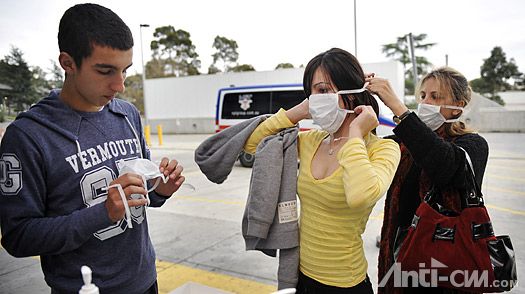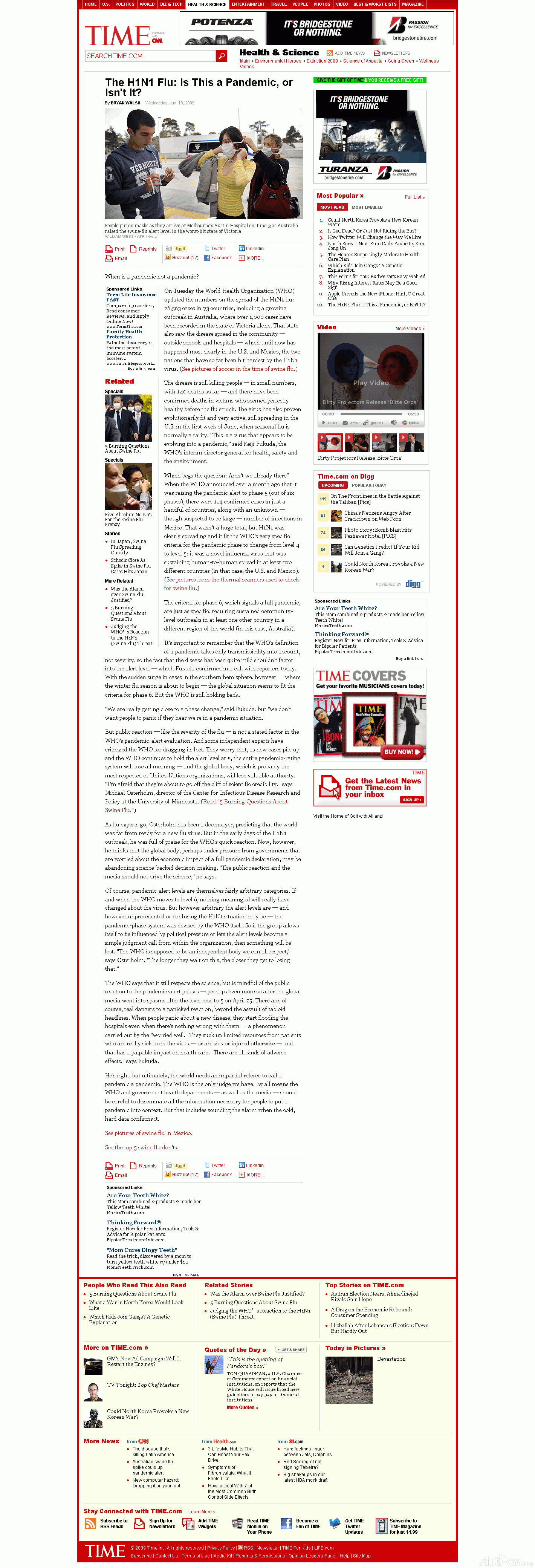|
|
The H1N1 Flu: Is This a Pandemic, or Isn't It?
http://www.time.com/time/health/article/0,8599,1903712,00.html
By Bryan Walsh Wednesday, Jun. 10, 2009

People put on masks as they arrive at Melbourne's Austin Hospital on June 3 as Australia raised the swine-flu alert level in the worst-hit state of Victoria
On Tuesday the World Health Organization (WHO) updated the numbers on the spread of the H1N1 flu: 26,563 cases in 73 countries, including a growing outbreak in Australia, where over 1,000 cases have been recorded in the state of Victoria alone. That state also saw the disease spread in the community — outside schools and hospitals — which until now has happened most clearly in the U.S. and Mexico, the two nations that have so far been hit hardest by the H1N1 virus.
The disease is still killing people — in small numbers, with 140 deaths so far — and there have been confirmed deaths in victims who seemed perfectly healthy before the flu struck. The virus has also proven evolutionarily fit and very active, still spreading in the U.S. in the first week of June, when seasonal flu is normally a rarity. "This is a virus that appears to be evolving into a pandemic," said Keiji Fukuda, the WHO's interim director general for health, safety and the environment.
Which begs the question: Aren't we already there? When the WHO announced over a month ago that it was raising the pandemic alert to phase 5 (out of six phases), there were 114 confirmed cases in just a handful of countries, along with an unknown — though suspected to be large — number of infections in Mexico. That wasn't a huge total, but H1N1 was clearly spreading and it fit the WHO's very specific criteria for the pandemic phase to change from level 4 to level 5: it was a novel influenza virus that was sustaining human-to-human spread in at least two different countries (in that case, the U.S. and Mexico).
The criteria for phase 6, which signals a full pandemic, are just as specific, requiring sustained community-level outbreaks in at least one other country in a different region of the world (in this case, Australia).
It's important to remember that the WHO's definition of a pandemic takes only transmissibility into account, not severity, so the fact that the disease has been quite mild shouldn't factor into the alert level — which Fukuda confirmed in a call with reporters today. With the sudden surge in cases in the southern hemisphere, however — where the winter flu season is about to begin — the global situation seems to fit the criteria for phase 6. But the WHO is still holding back.
"We are really getting close to a phase change," said Fukuda, but "we don't want people to panic if they hear we're in a pandemic situation."
But public reaction — like the severity of the flu — is not a stated factor in the WHO's pandemic-alert evaluation. And some independent experts have criticized the WHO for dragging its feet. They worry that, as new cases pile up and the WHO continues to hold the alert level at 5, the entire pandemic-rating system will lose all meaning — and the global body, which is probably the most respected of United Nations organizations, will lose valuable authority. "I'm afraid that they're about to go off the cliff of scientific credibility," says Michael Osterholm, director of the Center for Infectious Disease Research and Policy at the University of Minnesota.
As flu experts go, Osterholm has been a doomsayer, predicting that the world was far from ready for a new flu virus. But in the early days of the H1N1 outbreak, he was full of praise for the WHO's quick reaction. Now, however, he thinks that the global body, perhaps under pressure from governments that are worried about the economic impact of a full pandemic declaration, may be abandoning science-backed decision-making. "The public reaction and the media should not drive the science," he says.
Of course, pandemic-alert levels are themselves fairly arbitrary categories. If and when the WHO moves to level 6, nothing meaningful will really have changed about the virus. But however arbitrary the alert levels are — and however unprecedented or confusing the H1N1 situation may be — the pandemic-phase system was devised by the WHO itself. So if the group allows itself to be influenced by political pressure or lets the alert levels become a simple judgment call from within the organization, then something will be lost. "The WHO is supposed to be an independent body we can all respect," says Osterholm. "The longer they wait on this, the closer they get to losing that."
The WHO says that it still respects the science, but is mindful of the public reaction to the pandemic-alert phases — perhaps even more so after the global media went into spasms after the level rose to 5 on April 29. There are, of course, real dangers to a panicked reaction, beyond the assault of tabloid headlines. When people panic about a new disease, they start flooding the hospitals even when there's nothing wrong with them — a phenomenon carried out by the "worried well." They suck up limited resources from patients who are really sick from the virus — or are sick or injured otherwise — and that has a palpable impact on health care. "There are all kinds of adverse effects," says Fukuda.
He's right, but ultimately, the world needs an impartial referee to call a pandemic a pandemic. The WHO is the only judge we have. By all means the WHO and government health departments — as well as the media — should be careful to disseminate all the information necessary for people to put a pandemic into context. But that includes sounding the alarm when the cold, hard data confirms it.

|
Flu, isn, Pandemic, The, 时代周刊, Flu, isn, Pandemic, The, 时代周刊, Flu, isn, Pandemic, The, 时代周刊
|